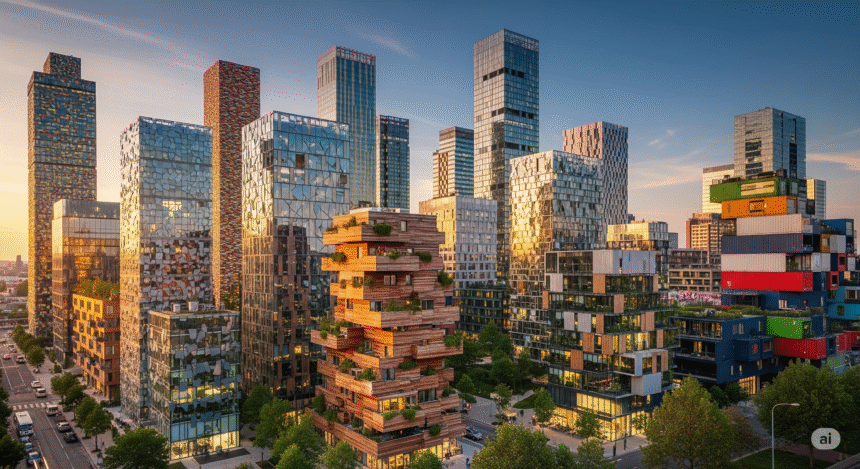As cities grow and natural resources become harder to come by, the construction industry is finding creative ways to build, without breaking the planet. One of the most unexpected changes? Turning trash into actual building materials. Around the world, engineers, builders, and even environmental groups are finding that waste can be much more than something to toss; it can be the backbone of modern infrastructure. Here are nine materials that used to be considered garbage but are now being used to build homes, roads, and even entire neighborhoods.
1. Plastic Waste Bricks
Plastic waste is piling up everywhere in rivers, oceans, and landfills. But in some parts of the world, people are giving it a new role. In countries like Colombia and India, plastic is being melted down, mixed with sand, and molded into bricks. These bricks are surprisingly sturdy, lightweight, and even resist fire.
Not only does this approach help cut down on plastic pollution, but it also makes it easier to build low-cost housing. What was once a major waste problem is now part of the solution to another affordable shelter.
2. Recycled Glass in Construction
We all toss out glass bottles, but not all of it makes its way back into new bottles. That’s where the construction world steps in. Crushed glass, sometimes called glass cullet, is now being used in place of sand in concrete mixes or asphalt.
With the world running low on natural sand, using glass this way reduces pressure on natural resources. It also gives the material a subtle sparkle and can even reflect light better. Roads and pavements in several countries, including the US and UK, are already being laid with it.
3. Cigarette Butts in Bricks
It might sound strange, but cigarette filters, the most littered item globally, are now being added to bricks. Researchers in Australia discovered that when you add them to clay bricks and bake them, the end result is lighter and better at keeping in heat.
It also means using less energy in the brick-making process. While still in the early stages, this technique has the potential to keep billions of cigarette butts out of landfills and off the streets.
4. Reclaimed Wood
Old wood from demolished buildings, shipping crates, or barns is finding new life in modern architecture. This “reclaimed” wood is often stronger than freshly cut lumber, thanks to years of natural drying and curing.
Designers love its character; the knots, nail marks, and weathered grain tell a story. More importantly, reusing wood helps reduce the demand for fresh timber, which protects forests and cuts down on waste.
5. Fly Ash in Concrete
Coal-fired power plants produce fly ash, a fine, powdery substance, as a leftover by-product. For years, it ended up in landfills. But now it’s being mixed into concrete, making it stronger and longer-lasting.
Not only does this reduce the need for cement (which is highly carbon-intensive to produce), it also helps deal with a major waste stream from the energy industry. Infrastructure projects across Asia and the US have already adopted this method, especially in large-scale construction.
6. Crushed Construction Debris
Broken bricks, old tiles, and torn-up concrete from demolition sites used to go straight to the dump. Now, these leftovers are being sorted, crushed, and reused in new builds. They’re often used in road bases, paving, or even new concrete blocks.
This process saves money, keeps landfills from overflowing, and reduces the need to mine fresh materials. Many European countries have made it standard practice in public projects.
7. Shipping Containers as Buildings
Used shipping containers, those giant steel boxes once used for transport, are being repurposed into homes, cafes, offices, and even schools. They’re sturdy, easy to move, and can be stacked or combined to create larger spaces.
With a little insulation and thoughtful design, containers can be surprisingly comfortable and energy-efficient. What was once rusting away in ports is now being used for quick, low-cost construction across cities like Amsterdam, Cape Town, and Mumbai.
8. Rubber from Used Tires
Used tires are tough to get rid of and often end up dumped illegally or burned. But some cities are using shredded tire rubber in road construction. When mixed into asphalt, the rubber helps roads last longer and stay quieter.
It’s already being used in parts of the US and Europe, and some studies suggest it may even reduce traffic noise. Plus, it helps keep millions of tires from sitting in dumps or catching fire.
9. Scrap Aluminum and Cans
Aluminum is one of the few metals that can be recycled endlessly without losing quality. Discarded cans and leftover industrial scrap are now being turned into window frames, roof panels, and decorative cladding.
What makes this practice even more useful is that recycling aluminum uses far less energy than producing new metal. Entire buildings are being covered in repurposed aluminum, adding both style and function, especially in urban centers like Tokyo and Berlin.
Rethinking What We Throw Away
The construction industry is slowly proving that one person’s trash really can be another person’s building block. Whether it’s an old bottle, a cigarette butt, or a worn-out tire, these materials are showing up in places we never expected, and they’re doing a solid job.
As more builders and city planners embrace this shift, our cities could become cleaner, smarter, and more resourceful all by using what we already have.







